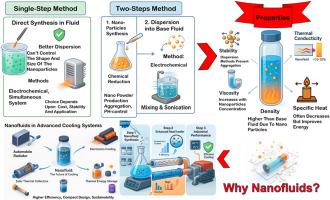纳米材料工程流体在冷却系统:从制备到性能的综合综述
IF 16.3
1区 工程技术
Q1 ENERGY & FUELS
引用次数: 0
摘要
发动机、电子和工业过程中对高效冷却系统的需求日益增长,需要先进和创新的热管理解决方案。传统的冷却方法受到一些限制,导致性能降低和部件损坏。现代冷却系统使用纳米流体作为冷却剂,提供更好的导热性和传热效率。含有金属、金属氧化物、碳化物、碳纳米结构(碳纳米管、石墨烯等)的纳米流体表现出增强的传热性能和高稳定性。纳米流体的开发采用了多种策略,这取决于所涉及的纳米材料和流体成分以及所采用的方法。纳米材料和基液的合成方法、关键的热物理性质(导热系数、粘度、比热容、密度)决定了纳米流体的最终响应。通过选择合适的纳米材料,纳米流体的响应可以有效地针对不同的应用,例如,微处理器冷却,汽车散热器,太阳能集热器和先进的热交换器等。工程纳米流体可能在热能收集和再利用中发挥潜在作用,但纳米颗粒团聚、粘度增加、能量需求和环境问题等仍是有待解决的挑战。本文综述了基于智能纳米材料的先进纳米流体的最新研究进展,这些纳米流体可能为未来热管理提供潜在的解决方案。本文章由计算机程序翻译,如有差异,请以英文原文为准。

Nanomaterial-engineered fluids in cooling Systems: From preparation to performance–A comprehensive review
The increasing demand for efficient cooling systems in engines, electronics and industrial processes requires advanced and innovative solutions in thermal management. Traditional cooling methods suffer from several limitations, leading to reduced performance and damage of components. Modern cooling systems use nanofluids as coolants offering improved thermal conductivity and heat transfer efficiency. Nanofluids containing metals, metal oxides, carbides, carbon nanostructures (CNTs, Graphene, etc.) exhibit enhanced heat transfer properties with high stability. Nanofluids are developed by using several strategies and it all depends upon involved nanomaterial and fluidic components and also the adopted methodology. The synthesis methodology, key thermophysical properties (thermal conductivity, viscosity, specific heat capacity, density) of nanomaterials and of base fluid determine the final response of nanofluids. By selecting appropriate nanomaterials, the response of nanofluids can be effectively tailored for diverse applications, e.g., microprocessor cooling, automotive radiators, solar collectors, and advanced heat exchangers, etc. Engineered nanofluids could play a potential role in thermal energy harvesting and reuse but the nanoparticle agglomeration, increased viscosity, energy requirements, and environmental concerns, etc., are open challenges. This review presents the state-of-the-art research progress in the direction of smart nanomaterials based advanced nanofluids that could offer potential solutions as promising frontiers in future thermal management.
求助全文
通过发布文献求助,成功后即可免费获取论文全文。
去求助
来源期刊

Renewable and Sustainable Energy Reviews
工程技术-能源与燃料
CiteScore
31.20
自引率
5.70%
发文量
1055
审稿时长
62 days
期刊介绍:
The mission of Renewable and Sustainable Energy Reviews is to disseminate the most compelling and pertinent critical insights in renewable and sustainable energy, fostering collaboration among the research community, private sector, and policy and decision makers. The journal aims to exchange challenges, solutions, innovative concepts, and technologies, contributing to sustainable development, the transition to a low-carbon future, and the attainment of emissions targets outlined by the United Nations Framework Convention on Climate Change.
Renewable and Sustainable Energy Reviews publishes a diverse range of content, including review papers, original research, case studies, and analyses of new technologies, all featuring a substantial review component such as critique, comparison, or analysis. Introducing a distinctive paper type, Expert Insights, the journal presents commissioned mini-reviews authored by field leaders, addressing topics of significant interest. Case studies undergo consideration only if they showcase the work's applicability to other regions or contribute valuable insights to the broader field of renewable and sustainable energy. Notably, a bibliographic or literature review lacking critical analysis is deemed unsuitable for publication.
 求助内容:
求助内容: 应助结果提醒方式:
应助结果提醒方式:


